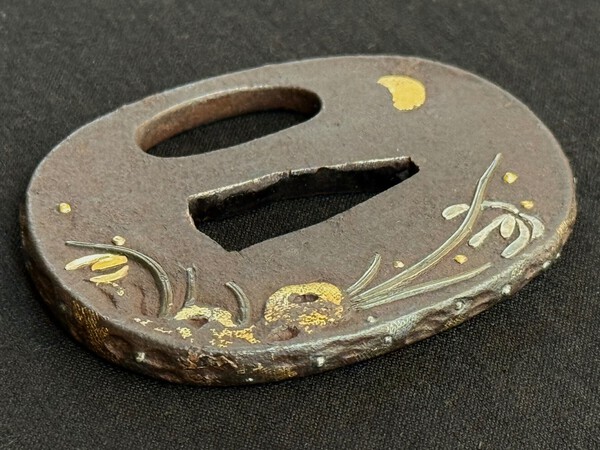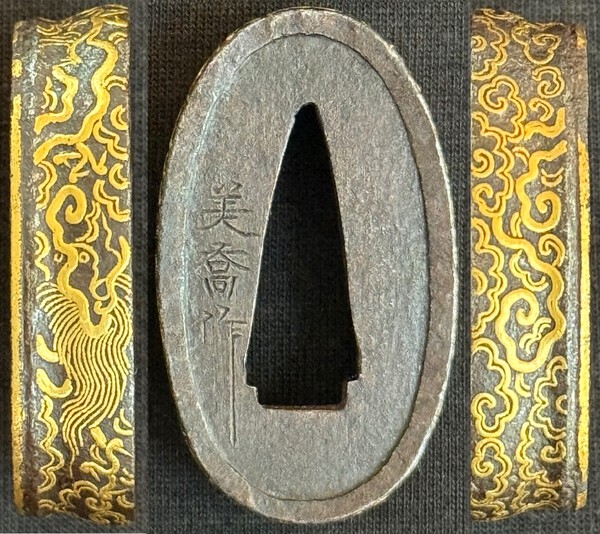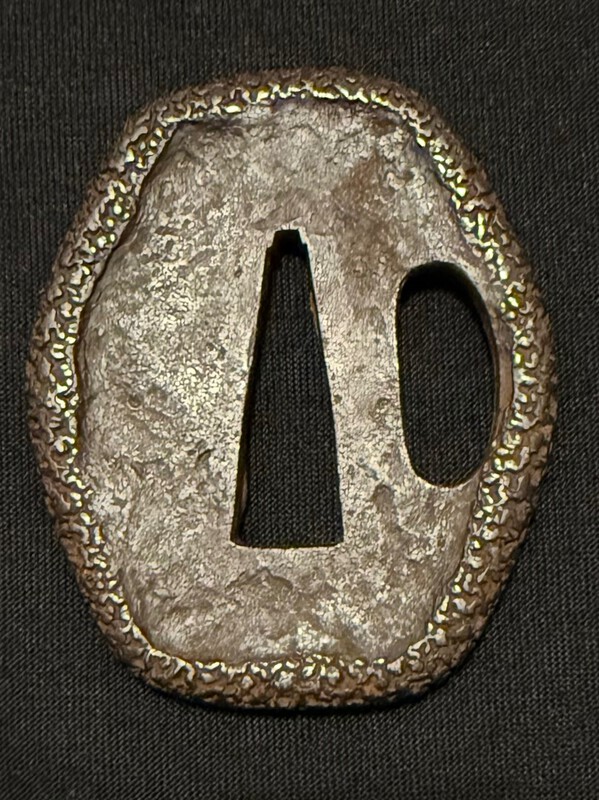-
Posts
563 -
Joined
-
Last visited
-
Days Won
2
Content Type
Profiles
Forums
Events
Store
Downloads
Gallery
Everything posted by Tcat
-
Japanese yes, late muromachi period.
-
The tsuba is signed “Yoshitaka saku” - I think this is referring to Komai Yoshitaka (駒井美雄) , oldest of three sons of Komai Seibei (駒井清兵衛) who founded the Komai school in 1841. Yoshitaka was born the same year. The Komai brand later became famous for making overlayed cigarette cases, decorative boxes and similar works. Signature examples (the second is not to my knowledge authenticated, but I believe it): More info on the famous “S. Komai” school and its origins - http://www.smokingsamurai.com/KOMAI_S.html
-
The mimi on this little tsuba is pretty cool, perhaps the star of the show. The work goes all around like in the photo above so looks really good side on or when mounted. No takers at 85 USD shipped? Bumping with a special NMB Ninja price of $75 shipped CONUS, (add 11 bucks for international shipping). I will donate $10 of proceeds from this sale to Brian for NMB server upkeep. If you pay 85 I’ll send him 20! 🤣
-
Nice. This is a WWII era sword, upper pic sig reads "Koa Isshin Mantetsu Kin Saku" meaning Asia one heart - made of mantetsu, then on the other side the date reads Showa Mizunoe-Uma Haru - spring 1942.
-
Hi all. Without overthinking it seems to be a meiji era kaiken. Quality is quite good for the era, not a cheap tourist item but also not a treasure per se. The lacquerwork is done well, with nice abalone inlays. Fittings are good but not outstanding. The blade has 'Hachiman Okami' carved into one side with a late-style looking horimono. On the other we have grass script horimono and birds. Decent horimono both sides. My guess is that its a legit meiji era 'wedding sword' kaiken worn by the bride.
-
Well… the results are in. Nearly a quarter of a million dollars for the Rai Kunitoshi tanto. It seems that everything which sold did so for higher than estimate, but a fair number went unsold. A juyo Higo koshirea though rather plain sold for 31k haha. Funny old world.
-
Will be interesting to see the results of the Sotheby's sale too...
-

SOME THOUGHTS ON BEGINNING THE COLLECTION OF TSUBA by Arnold Frenzel
Tcat replied to Spartancrest's topic in Tosogu
Hi Dale, great work and good to see you back online here. -
Price slash - $85 shipped with tracking CONUS. International buyers can request shipping provider and will get an $11 discount on the final price with shipping.
-

My First Nihonto - What was yours like?
Tcat replied to Yumso's topic in General Nihonto Related Discussion
-
I can vouch for Artur. Many happy transactions... He has a few very nice koshirea on sale now - rare, beautiful and not common in the market especially at that price. PS. Nice armor there Blake.
-
Hi Simon, I think for a first attempt you did a good job. The untrained eye is unlikely to notice anything too far amiss. Is the blade completely secure and aligned in the tsuka and can it be removed and replaced with ease? If the answer is yes, then well done on that. The next time you do one, you will know what you're in for, and the result will be improved further. I have tried my hand at woodworking parts for swords and it is a true test of accuracy/tolerance. I once made a tsuka for shirasaya and the result worked but it took me forever and looked not as good as yours. Anyway, you've done well and there's a serious shortage of people able to mount swords these days. Keep practising and one day people might be paying you to do it...
- 4 replies
-
- 1
-

-
- koshirae
- restoration
-
(and 1 more)
Tagged with:
-
Edo era iron and mixed-metal Tsuba for a tanto decorated with gold, silver and shakudo inlay in the form of a Lily on both ura and omote sides. The mimi is also decorated with patches of nunome zogan gold crosshatching together with silver / shakudo dot inlay and hammer strikes. Dimensions: 55mm x 44mm x 4mm $125 shipped tracked and insured CONUS.
-
Price slash $125 shipped tracked and insured CONUS.
-
Price slash - $65 shipped, tracked and insured CONUS.
-
-
- 1
-




















